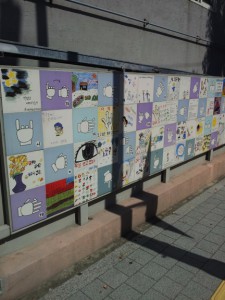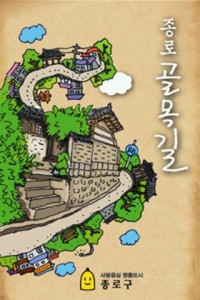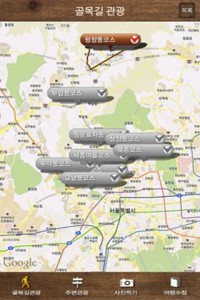Over the next four weeks Sam Collins and Matthew Durington are posting a series of writings that are theoretical and activity extensions based on their recently published book Networked Anthropology (Routledge).
The Man of the Crowd–Android Version
Collins downloads a free app from the Chongno District Government in Seoul, “Chongno Alleys” (종로 골목길). The app is an extension of the Chongno tour series (of the same name), each course highlighting lesser known places of interest in Chongno, the central district in Seoul that is home to the lion’s share of Seoul’s national treasures, including palaces, countless museums and architectural landmarks. But these tours are different. Developed with neighborhood residents and community groups, these alley courses highlight significant places that are generally overlooked by large crowds of tourists. It is targeted specifically at Korean tourists (that is, the app is only in Korean). The app (which appears to have been released in 2011-2012) transforms 9 of the alley tours into a mobile experience using mapping, GPS and gamification.
Opening course number 8, “Sejong Village,” takes Collins down narrow alleys to 1). a white-barked pine tree that is a descendent of a former “natural national monument” (천연기념날), down a maze of modest hanok (한옥) homes to the former residence of a resistance fighter against the Japanese (Shim Ik-hee), and past government buildings, art galleries and boutique coffee houses to a tiled mural of student art from the National Seoul School for the Deaf and Blind.

(Student art and sign language instruction in front of the National Seoul School for the Deaf and Blind. Photo by Samuel Collins.)
As he closes in on each site, the GPS in his smartphone highlights the location on his map. When he gets within 1 km, he can get a “stamp” that confirms that he’s visited the site. The ultimate goal: getting all of the stamps for all of the courses. Finally, a link to his phone’s camera app means he can also create a “gallery” of images from his tours. He can also post comments to Twitter and Facebook. And he can see comments from other people who posted about these sites. One of the people who found the White Bark Pine Tree wrote “I almost died trying to find it”.
All in all, this is a fairly typical app: the combination of pre-existing content (descriptions, signage and photographs from the Chongno District government) combined with mapping, GPS, photo apps and social media.
But Collins found several things in this “alley tour” that departed from usual expectations and experiences of urban tourism. First, Collins’s GPS (on his second-hand, Samsung Galaxy phone) didn’t always accurately update his position and, in order to get his bearings in the narrow alleys of Sejong Village, he crossed back and forth several times before getting his phone to geo-locate correctly. In other words, he really did “tour” the alleys, crossing and re-crossing a narrow warren of streets and, in the process, taking in a good deal more of the neighborhood.
As structured as the tour may have been, the interface between different parts of the app, together with the limitations of Collins’s smartphone, made even this pre-packaged experience into a “dérive” that brought him to dead-ends and unexpected gardens. While “dérive,” as “the search for an encounter with otherness, spurred on in equal part by the exploration of of pockets of class, ethnic and racial difference in the postwar city” (McDonough 2009: would seem to be the exact opposite of tourism (with its commodified and canned experiences), the interstices between the interfaces meant that Collins wandered over into encounters with the “other” whether he planned to or not, including a memorable moment when he walked down a dead-end alley into a group of elderly men gambling in the street.
And there was another sense that the app exceeded its own goals of taking the tourist along the road “less taken”: the encounter with sites and agencies that undermined the vague patriotism that animated the rest of the tour. For example, Sejong Village (known as “Seochon” before 2010), abuts the complex of buildings surrounding the home of South Korea’s President (청와대). It may look like a charming, idyllic neighborhood, but Collins noted scores of men with sunglasses and studied, casual dress (shirts untucked!)–the secret service protecting the Blue House from threats to national security. Two of them asked him where he was from–but it wasn’t in order to make conversation. Here, the political realities of a Korea still grappling with the legacy of colonialism and the Cold War intrude on the touristic.

(The front-page to the “Chongno Alley” app from the Chongno District Government)

(A series of available courses and a toolbar that features geo-location, a photo gallery, and possibilities for social media)
Anthropology in/of apps
We find it curious that anthropologists have paid relatively little attention to apps. Yes, there are certainly apps that help in our ethnographic research (we have been big fans of “Evernote” for years), and apps have long been utilized by artists, folklorists, community activists and many others to encourage people to “read” and experience the city in ways that may contravene the commodified spaces of the neoliberal city. We’re fans of the “Dérive” app, a series of commands that a user scrolls through as they wander a city, the intent of which is to literally lose you in the streets you thought you knew: a deeply subversive exercise that may be as close as the digital world comes to the Situationist project. And yet, when the ethnographic begins to look too much like tourism (as in the above), anthropologists have not been as academically interested, even though they may work on these same projects in their applied projects.
But there are many things for our work here:
First, apps offer a coherent, purposeful ideological structuring of space, narrative and practice. They facilitate embodied ideologies, and they mark the exact point of interpellation where structure and symbol meet practice and bodily hexis. Apps show how institutions and other powerful agents are trying to structure the meaning of cities by combining mobile media and social media through organizing embodied narrative experiences. Even when apps reproduce already existing content, they do so by structuring experiences in ways that are illustrative of networked power: the city as a series of connections and disconnections that bring some spaces and meaning together while effectively cutting off vast parts of the city from urban practice. In other words, apps are technologies of inclusion and exclusion, and following their trail can tell us exactly how things like segregation work in an era of the actor network.
Second, these powerful tools are not perfect. In fact, they’re riven with errors–one of the reasons we like Android-based apps is for all of these lumps and bugs. But these are more than simply programmer’s errors–we think of them more like Freudian parapraxes. That is, apps show where there are contradictions, tensions and possibilities for alternative meanings in the interstices of interlocking media platforms. Like the GPS system that can’t keep up with spatio-temporal shifts of neoliberalism, apps can show us fissures where the exercise of power is still incomplete, the space between symbol, structure and practice that allows for the articulation (or at least the evocation) of difference. By definition, geo-locatonal apps introduce a gap between structure and practice. For scholars like Jason Farman, they are a clarion call for “creative misuse”. For us, they remind us that utopia lies in the interstices of the urban fabric.
Third, apps allow anthropologists unparalleled opportunities to organize our multimedia, ethnographic data. We’re used to working (and re-working) our notes, transcripts and recordings for written ethnographies, or editing (and re-editing) audio and visual recordings for ethnographic film, but what happens when we’ve got all of the above? Increasingly, anthropologists are leaving the field with a panoply of media: recordings, notes, photos, digital records, etc. Apps suggest one way of integrating this into ethnographically intended experiences for users. And there are multiple platforms for anthropologists to use in their own research. We’ve been experimenting with ARIS, an open-source editor for making multimedia apps for the iPhone, but there are other possibilities out there, including MIT App Inventor.
Moreover, forcing ourselves to organize maps, film, photos, archives and interviews into a (semi)coherent user experience is not just a difficult exercise, it’s a form of ethnographic analysis. Apps take ethnographers to task for assuming that meaning “inheres” in objects or spaces–with a geo-located app of an urban neighborhood, meaning comes from the ethnographic practice of the user. Can the user interact with your site in a way that is consonant with your own conclusions? And if they don’t, isn’t that a problem for you to consider? Unlike more traditional forms of dissemination (ethnographic and film), apps offer anthropologists a level of feedback (through user-generated content, app analytics or exit interviews) we usually don’t receive until months after our work is published (if at all). This feedback is itself data–where people go, where they don’t go, what they saw and what they failed to see. If we dismiss this as ephemeral to our research, we’re missing the point: this is where the ethnography (literally) hits the road.
Finally, apps suggest an ethnography that is collaborative, engaging, open and fluid. Working with people to produce multiple media, prototyping apps with our interlocutors, testing apps with students, collecting data from usage, and then re-working what we’ve done to reflect our new understanding, all under the auspices of an open-source, open-access platform that people can utilize on even a cheap, 3G phone (like Collins’s). Is this the future? Maybe not–but it is one more proof (as if Savage Minds readers needed more) that monographs and articles may not be the best path towards an engaged, public anthropology.
References
McDonough, Tom (2009). “Introduction.” In The Situationists and the City, ed. by Tom McDonough, pp. 1-31. NY: Verso.
Hit us up on twitter: @mdurington @samuelcollins43 @networkedanthro
This article is, I suggest, too perfectly sensible and coherent to attract much comment. I enjoyed reading it very much and even downloaded the dérive app and played with it a bit. But, in contrast to Android apps with their lumps and bugs, this piece is like an iOS app, so beautifully crafted that there are no fissures in which to jam the usual sorts of critical responses. I recall Henry Jenkins remarking in Convergence Cultures on the art of modern movie making/merchandising that bits of unfinished business are left as hooks to engage fan involvement. Jenkins sees this, quite rightly I think, as a deliberate departure from the idea of the “work” as a finished object or canvas confined within its own frame. Just brainstorming a bit. . . .